中国文学与艺术期末试题
中国文学期末考试题及答案杭师大

中国文学期末考试题及答案杭师大一、单项选择题1、《诗经》(C)篇作品,代表着2500年前约500多年间的诗歌创作成就。
A、355B、310C 、 305D、3002、我们现在看到的《庄子》,都源于晋代郭象注本《庄子》,此本分内篇七、外篇(A )杂篇十一。
A、15B、10C、 8D、133、《九歌》共(A)篇,与题目所示”九”不同。
A11B、12C、 13D、144、”兼爱”是(B)A孔子的中心思想B、墨子的中心思想C、孟子的中心思想D、庄子的中心思想5、司马迁《史记》作为纪传体史学著作,其叙事(C)。
A、以历史事件为中心B、以朝代更迭为中心C、以历史人物为中心D、以作者的历史观为中心6、《战国策》在编纂体例上属于(A)A、国别体B、纪传体C、编年体D、纪事本末体7、标志着我国叙事诗成熟的创作是(B)A、诗经B、汉乐府民歌C、南朝乐府民歌D、唐代新乐府诗8、刘鳃《文心雕龙-明诗》对《古诗十九首》的评价是(C)A、惊心动魄,一字千金B、发于天赖,本乎人情C、婉转附物,韶怅切情D、凭空模拟,文法极奇9、代表曹操悲凉沉雄诗风的名句是(B)A、置酒高堂,悲歌临觞。
人寿几何,逝如朝霜B、慨当以慷,忧思难忘。
何以解忧,唯有杜康C、目送归鸿,手挥五弦。
俯仰自得,游心太玄D、遗荣荣在,外身身全。
卓哉先师,修德就闲10、主客问答是汉大赋的基本结构方式。
《七发》中的主、客是(D)A、子虚先生与乌有先生B、西都宾与东都主人C、凭虚公子与安处先生D、吴客与楚太子11、”朝扣富儿门,暮随肥马尘。
残杯与冷炙,到处潜悲辛。
”这几句诗写杜甫在长安,历尽人生辛酸,这是他在(B )一诗中的句子。
A、《自京赴奉先县永怀五百字》B、《奉赠韦左丞仗二十二韵》C、《述怀》D、《春望》12、韩愈的名句”最是一年春好处,绝胜烟柳满皇都”是以下那首诗中的句子:(C)A、《盆池五首》B、《晚雨》C、《早春呈水部张十八员外二首》D、《县斋有怀》13、钱锺书《谈艺录》”豪侠之气未除,真率之相不掩,欲正仍奇,求厉自温”评的是以下哪一位诗人的诗?(B)A、孟郊B、韩愈C、李贺D、卢全14、(A )虽比张孝祥年长7岁,比辛弃疾年长15岁,但词作不多,开创性不大。
中国古代文学专题(唐诗宋词)期末复习题及参考答案
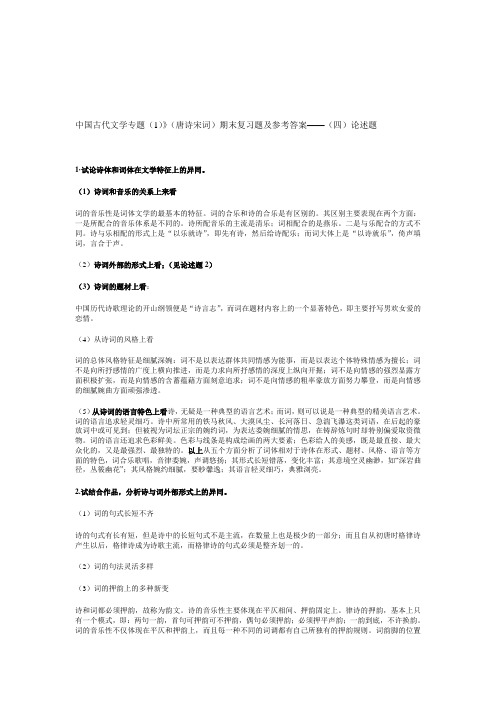
诗,无疑是一种典型的语言艺术;而词,则可以说是一种典型的精美语言艺术。词的语言追求轻灵细巧。诗中所常用的铁马秋风、大漠风尘、长河落日、急湍飞瀑这类词语,在后起的豪放词中或可见到;但被视为词坛正宗的婉约词,为表达委婉细腻的情思,在铸辞炼句时却特别偏爱取资微物。词的语言还追求色彩鲜美。色彩与线条是构成绘画的两大要素;色彩给人的美感,既是最直接、最大众化的,又是最强烈、最独特的。词的语言风格也是多样化的,色彩鲜艳是一种美,本色自然也是一种朴素的美;如果能把握其度,浓淡适中,则又是一种美。
13·试结合作品分析送别诗诃中的“杨柳”这一意象
杨柳,是中国古代送别诗中描写得最多、也是最优美动人、情意缠绵的一个意象。追溯一下最早在诗中写到杨柳、并且对后世产生很大影响的是先秦第一部诗歌总结——《诗经》中的《小雅·采薇》篇。《小雅。采薇》篇描写的是战后幸存的征人,于归家途中抚今追昔的万千感慨。诗共六章,最后一章中“昔我往矣,杨柳依依;今我来兮,雨雪霏霏”四句,最为后人所称道。杨柳的依依之态和人们的依依惜别之情和谐地交融在一起,使“杨柳”这个意象开始注入了惜别之情的意蕴。汉乐府《横吹曲》中有《折杨柳》曲。因为杨柳和离别的关系密切,致使《折杨柳》曲也多写离愁别绪。其次,杨柳的意象跟离别联系在一起,还有一个因素,就是在汉字中“柳”与“留”谐音相近,折柳送别,暗中寄寓殷勤挽留的意愿。宋词中的“杨柳”意象也十分丰富。淇中有的是作为实物来歌咏春天风景或伤春惜春之情的。如晏殊《诉衷情》词中有旬日:“春风杨柳欲青青,烟淡雨初晴。”但是,宋词中写到杨柳的,更多的还是承袭了唐诗和前人诗中“杨柳”意象的本意,即跟离情结合在一起。这样的例子很多,柳永惜别名篇《雨霖铃》中有名旬日:“多情自古伤离别,更那堪冷落清秋节。今宵酒醒何处,杨柳岸晓风残月。”关于送别诗中为什么多写杨柳,归结为两点:一是表示依依惜别之情,二是表示殷勤挽留之意。杨柳已成为我国古典诗歌的常用意象
《文学学(2)》2022-2023期末试题及答案

《文学学(2)》2022-2023期末试题及答案文学学(2) 2022-2023期末试题及答案
考试时间:2小时
总分:100分
第一部分:选择题 (共40题,每题2分,共80分)
1. 下列哪个选项不是文学研究的方法?
- A. 历史研究法
- B. 实证研究法
- C. 形式主义研究法
- D. 文本阅读法
2. 以下哪个是中国古代文学的代表作?
- A. 《红楼梦》
- B. 《西游记》
- C. 《水浒传》
- D. 《三国演义》
...
40. 以下哪个人物是被认为是伟大的战争诗人?
- A. 李白
- B. 杜甫
- C. 白居易
- D. 苏轼
第二部分:简答题 (共3题,每题10分,共30分)
1. 请简述现代主义文学的特点及其对文学发展的影响。
2. 解释文学批评中的"内在评价"和"外在评价"的概念。
3. 请阐述文学作品中的主题与情节之间的关系。
第三部分:论述题 (共2题,每题20分,共40分)
1. 详细评述一位你欣赏的现代作家,并就他/她的作品风格、主题和影响进行讨论。
2. 选择一本你最喜欢的文学作品,解读其中的象征意义并分析其文学价值。
第四部分:附加题 (共1题,20分)
1. 以中国古代诗词为例,讨论诗词创作中的音韵和格律对于诗意表达的重要性,并以具体作品分析论证。
注意事项:
- 请将选择题答案填写在答题卡上,简答题和论述题请用书面语作答在答题卷上。
- 翻译文学作品标题时,请遵循相应的翻译规范。
祝你考试顺利!。
2021年大学国文期末考试满分答案

大学国文(下)期末考试满分答案一、单选题(题数:50,共 50.0 分)1开拓了词形式和内容是()。
(1.0分)1.0分对的答案:C 我答案:C2与苏轼并称为书法界“宋四家”不涉及()。
(1.0分)1.0分对的答案:D 我答案:D3出自《和子由渑池怀旧》成语“雪泥鸿爪”比喻是()。
(1.0分)1.0分对的答案:D 我答案:D4继承了花间派风格词人是()。
(1.0分)1.0分对的答案:B 我答案:B5关于顾炎武简介,下列说法对的是()。
(1.0分)1.0分对的答案:B 我答案:B6评析姜夔《暗香》,此词咏梅怀人,思今念往。
遥指当年()旧事。
(1.0分)1.0分对的答案:D 我答案:D7《摸鱼儿》这首词艺术特色不涉及()。
(1.0分)1.0分对的答案:D 我答案:D8不属于本文论证特色是()。
(1.0分)1.0分对的答案:B 我答案:B9方苞论文主张“义法”,是指()。
(1.0分)1.0分对的答案:D 我答案:D10如下不属于《断魂枪》中所采用老式论述方式是()。
(1.0分)1.0分对的答案:D 我答案:D11下列关于代,新诗发展说法对的是()。
(1.0分)1.0分对的答案:C 我答案:C12陆游诗作篇什逾万,至今尚存九千余首,有三首行世,其中不涉及()。
(1.0分)1.0分对的答案:C 我答案:C13下列关于沙子龙末世心态分析,说法对的是()。
(1.0分)1.0分对的答案:D 我答案:D14下列关于李叔同简介,说法不对的是()。
(1.0分)1.0分对的答案:C 我答案:C15《答司马谏议书》行文特点不涉及()(1.0分)1.0分对的答案:B 我答案:B16下列关于当代新诗简介,说法不对的是()。
(1.0分)1.0分对的答案:A 我答案:A17《萧萧》艺术成就涉及()。
(1.0分)1.0分对的答案:D 我答案:D18如下关于顾正冠说法不对的是哪一项?()(1.0分)1.0分对的答案:C 我答案:C19唐传奇《霍小玉传》作者是()。
2023年《文学艺术知识》试题及答案

2023年《文学艺术知识》试题及答案试题一:1. 请简述诗歌的特点及其分类。
答:诗歌是一种通过押韵和节奏来表达情感和思想的文学形式。
诗歌可以根据其押韵方式和内容主题进行分类,常见的分类包括押韵诗、无韵诗、抒情诗、叙事诗等。
2. 社会历史背景对文学艺术的影响是什么?答:社会历史背景对文学艺术有着深刻的影响。
社会历史背景可以塑造作家的思想观念和创作风格,也会影响作品表达的主题和情感。
文学艺术作品反映了当时社会的风貌和人们的关注点,同时也受到社会变革和思想潮流的影响。
3. 请列举几位中国古代文学家及其代表作品。
答:杜甫(《登高》、《月夜忆舍弟》)、李白(《静夜思》、《将进酒》)、苏轼(《赤壁赋》、《水调歌头》)、白居易(《长恨歌》、《琵琶行》)等是中国古代文学史上具有重要影响的文学家,他们的诗词作品至今仍然被广泛阅读和传诵。
试题二:1. 请简述戏剧的三大核心要素。
答:戏剧的三大核心要素包括剧本、表演和舞台美术。
剧本是戏剧的基础,用来构建故事情节和塑造角色形象;表演是将剧本通过演员的表演来呈现给观众;舞台美术则包括舞台布景、服装、灯光等元素,用来增强戏剧的视觉效果。
2. 请介绍一部中国古代名剧及其特点。
答:《红楼梦》是中国古代名剧的代表之一。
它是一部具有高度艺术价值的长篇小说,通过对贾宝玉等人物的描写展现了一个富有细腻情感和深刻人性思考的世界。
《红楼梦》中的人物形象具有丰满的个性,情节曲折复杂,并融入了大量的诗词和音乐元素,使其成为中国文学史上的瑰宝。
3. 现代舞台剧演出的基本流程是什么?答:现代舞台剧演出的基本流程包括剧本选题和创作、筹备阶段(包括演员选拔、舞台布景、服装设计等)、彩排和演出。
在剧本选题和创作阶段,编剧会根据剧目的主题和故事情节进行创作;在筹备阶段,剧组会进行各项准备工作;最后在彩排和演出阶段,演员将通过多次排练来完善演出效果,并最终在观众面前进行演出。
试题三:1. 请简要介绍中国古代绘画的发展历程。
国开电大本科中国现代文学专题期末考试试题及答案

国开电大本科中国现代文学专题期末考试试题及答案一、选择题(每题2分,共20分)1. 以下哪位作家是“新月派”的代表人物?A. 郭沫若B. 徐志摩C. 郭敬明D. 莫言答案:B2. 以下哪部作品是茅盾的长篇小说?A. 《家》B. 《春》C. 《子夜》D. 《边城》答案:C3. 以下哪位作家是“乡土文学”的代表人物?A. 莫言B. 陈忠实C. 茅盾D. 鲁迅答案:D4. 以下哪部作品是巴金的短篇小说?A. 《家》B. 《春》C. 《寒夜》D. 《憩园》答案:C5. 以下哪位作家是“伤痕文学”的代表人物?A. 刘心武B. 邓友梅C. 张抗抗D. 贾平凹答案:A二、填空题(每题2分,共20分)6. 中国现代文学的奠基人是_________。
答案:鲁迅7. 《呐喊》是_________的短篇小说集。
答案:鲁迅8. “乡土文学”的代表作品有_________、_________等。
答案:《边城》、《背影》9. “新月派”的诗歌特点是_________、_________。
答案:音律优美、意境深远10. 《子夜》是我国著名作家_________的长篇小说。
答案:茅盾三、名词解释(每题5分,共20分)11. 请简要解释“伤痕文学”。
答案:伤痕文学是指以揭示文化大革命时期社会伤痕为主题的一类文学作品。
这类作品主要反映了那个特殊时期人们的心灵创伤和社会现象,具有强烈的批判性和现实意义。
12. 请简要解释“新月派”。
答案:新月派是指20世纪初我国文学界的一群作家,以徐志摩、胡适等人为代表。
新月派主张文学创作要追求真、善、美,强调文学的审美价值,其诗歌作品具有音律优美、意境深远的特点。
13. 请简要解释“乡土文学”。
答案:乡土文学是指以反映农村生活、描绘农民形象为主题的文学作品。
这类作品通过真实地描绘农村生活,反映了农民的苦难和追求,具有鲜明的时代特色和民族风格。
14. 请简要解释“现代派”。
答案:现代派是指20世纪初我国文学界的一群作家,以鲁迅、茅盾等人为代表。
国家开放大学电大本科《中国现代文学专题》2023-2024期末试题及答案(试卷代号:1309)
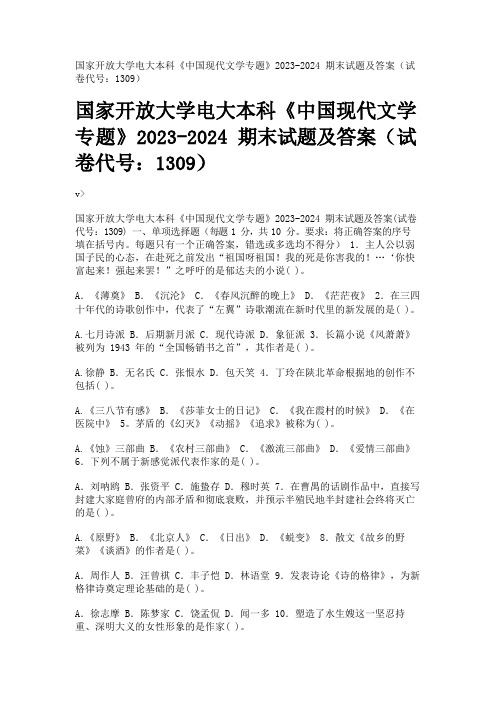
国家开放大学电大本科《中国现代文学专题》2023-2024 期末试题及答案(试卷代号:1309)国家开放大学电大本科《中国现代文学专题》2023-2024 期末试题及答案(试卷代号:1309)v>国家开放大学电大本科《中国现代文学专题》2023-2024 期末试题及答案(试卷代号:1309) 一、单项选择题(每题 1 分,共 10 分。
要求:将正确答案的序号填在括号内。
每题只有一个正确答案,错选或多选均不得分) 1.主人公以弱国子民的心态,在赴死之前发出“祖国呀祖国!我的死是你害我的!…‘你快富起来!强起来罢!”之呼吁的是郁达夫的小说( )。
A.《薄奠》 B.《沉沦》 C.《春风沉醉的晚上》 D.《茫茫夜》 2.在三四十年代的诗歌创作中,代表了“左翼”诗歌潮流在新时代里的新发展的是( )。
A.七月诗派 B.后期新月派 C.现代诗派 D.象征派 3.长篇小说《风萧萧》被列为 1943 年的“全国畅销书之首”,其作者是( )。
A.徐静 B.无名氏 C.张恨水 D.包天笑 4.丁玲在陕北革命根据地的创作不包括( )。
A.《三八节有感》 B.《莎菲女士的日记》 C.《我在霞村的时候》 D.《在医院中》 5。
茅盾的《幻灭》《动摇》《追求》被称为( )。
A.《蚀》三部曲 B.《农村三部曲》 C.《激流三部曲》 D.《爱情三部曲》6.下列不属于新感觉派代表作家的是( )。
A.刘呐鸥 B.张资平 C.施蛰存 D.穆时英 7.在曹禺的话剧作品中,直接写封建大家庭曾府的内部矛盾和彻底衰败,并预示半殖民地半封建社会终将灭亡的是( )。
A.《原野》 B.《北京人》 C.《日出》 D.《蜕变》 8.散文《故乡的野菜》《谈酒》的作者是( )。
A.周作人 B.汪曾祺 C.丰子恺 D.林语堂 9.发表诗论《诗的格律》,为新格律诗奠定理论基础的是( )。
A.徐志摩 B.陈梦家 C.饶孟侃 D.闻一多 10.塑造了水生嫂这一坚忍持重、深明大义的女性形象的是作家( )。
2023年3月国开电大本科《中国现代文学专题》期末考试试题及答案

2023年3月国开电大本科《中国现代文学专题》期末考试试题及答案说明:本试卷总分为100分,占考核总成绩的70%。
考试时间90分钟。
一、单项选择题(每题1分,共10分。
要求:将正确答案的序号填在括号内。
每题只有一个正确答案, 错选或多选均不得分)1.五四时期发表《人的文学》一文,倡导“人的文学” “平民的文学"的是(B)。
A.鲁迅B.周作人C.胡适D.沈雁冰2.与冰心同为“小诗运动”重要诗人的是(B)。
A.汪静之B.宗白华C.徐志摩D.郭沫若3.在中国现代文学史上最早使用“幽默” 一词的人是(D)。
A.鲁迅B.沈从文C.丰子恺D.林语堂4.中国话剧正式拉开序幕的标志是1906年成立的社团(A)。
A.春柳社B.进化团C.民国戏剧社D.南国社5.20世纪30年代的文坛形成了三足鼎立的局面,三类文学各自拥有广泛的读者群,它们是(D)。
A.左翼文学、民族文学、新感觉派文学B.左翼文学、京派文学、解放区文学C.京派文学、新感觉派文学、国统区文学D.左翼文学、新感觉派文学、京派文学6.下列茅盾小说中不属于农村题材的是(A)。
A.《动摇》B.《春蚕》C.《秋收》D.《残冬》7.1930年加入左联,曾受到国民党的软禁,逃脱后前往陕北革命根据地继续进行创作的女作家是(B)。
A.萧红B.丁玲C.谢冰莹D.冰心8.张恨水小说中被认为与《红楼梦》有诸多相似之处的是(D)。
A.《啼笑因缘》B.《八十一梦》C.《五子登科》D.《金粉世家》9.在三四十年代的诗歌创作中,代表了“左翼”诗歌潮流新发展的是(A)。
A.七月诗派B.后期新月派C.现代诗派D.象征派10.描写东北地区一个叫元茂屯的村子从1946到1947年土地革命全过程的作品是(A)。
A.《暴风骤雨》B.《李家庄的变迁》C.《太阳照在桑干河上》D.《三里湾》二、填空题(每空2分,共30分。
要求:书写规范,不得有错别字)11.鲁迅的《补天》《理水》《非攻》等改写神话和历史题材的小说收入小说集《》。
中国现当代文学专题期末自测题
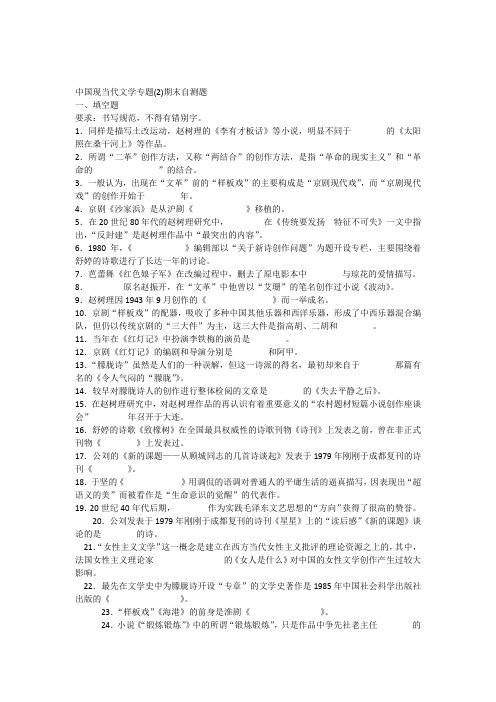
中国现当代文学专题(2)期末自测题一、填空题要求:书写规范,不得有错别字。
1.同样是描写土改运动,赵树理的《李有才板话》等小说,明显不同于的《太阳照在桑干河上》等作品。
2.所谓“二革”创作方法,又称“两结合”的创作方法,是指“革命的现实主义”和“革命的”的结合。
3.一般认为,出现在“文革”前的“样板戏”的主要构成是“京剧现代戏”,而“京剧现代戏”的创作开始于年。
4.京剧《沙家浜》是从沪剧《》移植的。
5.在20世纪80年代的赵树理研究中,在《传统要发扬特征不可失》一文中指出,“反封建”是赵树理作品中“最突出的内容”。
6.1980年,《》编辑部以“关于新诗创作问题”为题开设专栏,主要围绕着舒婷的诗歌进行了长达一年的讨论。
7.芭蕾舞《红色娘子军》在改编过程中,删去了原电影本中与琼花的爱情描写。
8.原名赵振开,在“文革”中他曾以“艾珊”的笔名创作过小说《波动》。
9.赵树理因1943年9月创作的《》而一举成名。
10.京剧“样板戏”的配器,吸收了多种中国其他乐器和西洋乐器,形成了中西乐器混合编队,但仍以传统京剧的“三大件”为主,这三大件是指高胡、二胡和。
11.当年在《红灯记》中扮演李铁梅的演员是。
12.京剧《红灯记》的编剧和导演分别是和阿甲。
13.“朦胧诗”虽然是人们的一种误解,但这一诗派的得名,最初却来自于那篇有名的《令人气闷的“朦胧”》。
14.较早对朦胧诗人的创作进行整体检阅的文章是的《失去平静之后》。
15.在赵树理研究中,对赵树理作品的再认识有着重要意义的“农村题材短篇小说创作座谈会”年召开于大连。
16.舒婷的诗歌《致橡树》在全国最具权威性的诗歌刊物《诗刊》上发表之前,曾在非正式刊物《》上发表过。
17.公刘的《新的课题——从顾城同志的几首诗谈起》发表于1979年刚刚于成都复刊的诗刊《》。
18.于坚的《》用调侃的语调对普通人的平庸生活的逼真描写,因表现出“超语义的美”而被看作是“生命意识的觉醒”的代表作。
《中国现代文学史》期末考试试卷及答案

《中国现代文学史》期末考试试卷及答案中国现代文学史期末考试试卷及答案一、选择题(40分)1. 以下哪部作品是《红楼梦》的作者所著?- A. 《西游记》- B. 《水浒传》- C. 《儿女英雄传》- D. 《红楼梦》答案:D2. 以下哪位作家是中国现代文学史上的重要代表人物?- A. 鲁迅- B. 孟樸- C. 杨绛- D. 老舍答案:A3. 以下哪部作品是《许渊冲自传的故事》的作者所著?- A. 《骆驼祥子》- B. 《国境以南,太阳以西》- C. 《边城》- D. 《许渊冲自传的故事》答案:D4. 以下哪位作家是中国女性文学的代表人物?- A. 王安忆- B. 余华- C. 高晓松- D.答案:A5. 以下哪部作品是中国现代文学史上的文学名著?- A. 《卧底苏联》- B. 《狼图腾》- C. 《活着》- D. 《白鹿原》答案:D二、简答题(60分)1. 简要介绍鲁迅的生平和他的主要作品。
答案:鲁迅(1881年-1936年)是中国现代文学史上的重要代表人物之一。
他的作品以犀利的批判和讽刺风格着称,对当时社会和人性的现实问题发出了强烈的声音。
他的主要作品包括《狂人日记》、《呐喊》、《彷徨》等,这些作品展现了他对封建制度、旧文化等的批判和关注。
2. 简述巴金的创作特点和他的代表作品。
答案:巴金(1904年-2005年)是中国现代文学史上的重要作家之一。
他的创作特点包括深入描绘人物的内心世界、注重社会真实性以及对人性的思考和揭示。
他的代表作品有《家》、《春》、《秋》等,这些作品既表现了社会的不公和人性的挣扎,也展现了对生活的热爱和希望。
3. 是中国女性文学的代表作家之一,请简要介绍她的生平和代表作品。
答案:(1958年-)是中国女性文学的代表作家之一。
她的作品揭示了女性在现代社会中的角色和问题,并以细腻的笔触和深入的洞察展现了生活的复杂性和矛盾性。
她的代表作品有《红字》、《云在青天上》、《殷海雪》等,这些作品引人深思,触动了读者对女性命运和社会现象的思考。
文学与文化期末考试题及答案

文学与文化期末考试题及答案一、选择题(每题2分,共20分)1. 《红楼梦》的作者是:A. 曹雪芹B. 罗贯中C. 施耐庵D. 吴承恩2. 下列哪部作品不属于莎士比亚的四大悲剧?A. 《哈姆雷特》B. 《奥赛罗》C. 《李尔王》D. 《罗密欧与朱丽叶》3. 以下哪位诗人被誉为“诗仙”?A. 杜甫B. 李白C. 王维D. 苏轼4. 《百年孤独》是以下哪位作家的代表作?A. 加西亚·马尔克斯B. 弗朗茨·卡夫卡C. 乔治·奥威尔D. 阿尔贝·加缪5. “文以载道”是哪位文学家的主张?A. 鲁迅B. 郭沫若C. 胡适D. 梁启超二、填空题(每空2分,共20分)6. 《悲惨世界》是法国作家________的作品。
7. “路漫漫其修远兮,吾将上下而求索”出自屈原的《________》。
8. 《神曲》是意大利诗人________的代表作。
9. 鲁迅的《阿Q正传》中,阿Q的全名是________。
10. “静以修身,俭以养德”是________的教育理念。
三、简答题(每题10分,共30分)11. 简述《安娜·卡列尼娜》中安娜的形象特点。
12. 描述《西游记》中孙悟空的性格特点。
13. 阐述“文艺复兴”对欧洲文化的影响。
四、论述题(每题15分,共30分)14. 论述《红楼梦》在中国文学史上的地位。
15. 分析《老人与海》中海明威的“冰山理论”。
文学与文化期末考试题答案一、选择题1. A2. D3. B4. A5. D二、填空题6. 雨果7. 离骚8. 但丁9. 阿桂10. 孔子三、简答题11. 安娜·卡列尼娜是俄国作家列夫·托尔斯泰的代表作《安娜·卡列尼娜》中的主角。
她是一个美丽、聪明、热情的女性,但同时也是一个悲剧人物。
安娜在婚姻中感到不幸福,她与军官瓦隆斯基的婚外情使她陷入了道德和法律的双重困境中。
安娜的形象反映了当时俄国社会对女性的限制和压迫,以及个人追求幸福与社会规范之间的冲突。
文学鉴赏的期末考试试题

文学鉴赏的期末考试试题文学鉴赏期末考试试题一、选择题(每题5分,共20分)1. 下列哪部作品是鲁迅先生的代表作之一?A. 《红楼梦》B. 《呐喊》C. 《平凡的世界》D. 《边城》2. “红楼一梦”指的是哪部古典文学作品?A. 《聊斋志异》B. 《金瓶梅》C. 《红楼梦》D. 《儒林外史》3. 以下哪位诗人被誉为“诗圣”?A. 李白B. 杜甫C. 王维D. 白居易4. 莎士比亚的“四大悲剧”中不包括以下哪部作品?A. 《哈姆雷特》B. 《奥赛罗》C. 《麦克白》D. 《罗密欧与朱丽叶》二、填空题(每题5分,共20分)1. 《百年孤独》是哥伦比亚作家________的代表作,被誉为魔幻现实主义文学的典范。
2. 《老人与海》是美国作家________的作品,该作品获得了1954年诺贝尔文学奖。
3. 唐代诗人王之涣的《登鹳雀楼》中,“欲穷千里目,更上一层楼”表达了诗人________的情怀。
4. 英国诗人雪莱的《西风颂》中,“冬天来了,春天还会远吗?”这句话象征着________。
三、简答题(每题15分,共30分)1. 简述《安娜·卡列尼娜》中安娜的形象特点及其悲剧命运。
2. 分析《哈姆雷特》中哈姆雷特的性格特征及其复仇行动的复杂性。
四、论述题(30分)请结合具体作品,论述中国古典文学中“侠义”精神的体现及其对后世的影响。
参考答案一、选择题1. B2. C3. B4. D二、填空题1. 加西亚·马尔克斯2. 海明威3. 积极向上,不断追求4. 希望与重生三、简答题1. 安娜·卡列尼娜是列夫·托尔斯泰笔下的一个复杂而立体的人物形象。
她美丽、聪明、热情,但同时也充满了矛盾。
在婚姻中,她感到不满足和束缚,因此她与军官沃伦斯基发生了婚外情。
安娜的悲剧命运在于她无法摆脱当时社会的道德束缚和偏见,最终在绝望中选择了自杀。
她的形象展现了女性在传统社会中的困境和挣扎,同时也反映了托尔斯泰对人性和社会的深刻洞察。
大学国文期末考试题及答案

大学国文期末考试题及答案一、选择题(每题2分,共20分)1. 下列哪个选项是《红楼梦》的作者?A. 曹雪芹B. 罗贯中C. 施耐庵D. 吴承恩答案:A2. “举头望明月,低头思故乡”出自哪位诗人之手?A. 李白B. 杜甫C. 王维D. 苏轼答案:A3. 鲁迅的《狂人日记》是在哪一年发表的?A. 1918年B. 1920年C. 1921年D. 1922年答案:A4. “水调歌头”是哪位词人的作品?A. 辛弃疾B. 苏轼C. 李清照D. 柳永答案:B5. 下列哪部作品不是老舍的代表作?A. 《骆驼祥子》B. 《四世同堂》C. 《茶馆》D. 《家》答案:D6. “但愿人长久,千里共婵娟”是哪位词人的名句?A. 辛弃疾B. 苏轼C. 李清照D. 柳永答案:B7. 《诗经》中的“国风”共有多少篇?A. 15篇B. 30篇C. 50篇D. 100篇答案:B8. 下列哪个成语与“破釜沉舟”意思相近?A. 背水一战B. 一鼓作气C. 临危受命D. 临阵磨枪答案:A9. “春眠不觉晓,处处闻啼鸟”出自哪部诗歌?A. 《春晓》B. 《春望》C. 《春夜喜雨》D. 《春江花月夜》答案:A10. 下列哪部作品是巴金的代表作?A. 《家》B. 《春》C. 《秋》D. 《冬》答案:A二、填空题(每空2分,共20分)11. 杜甫的《春望》中,“国破山河在,城春草木深”的下一句是“________”。
答案:感时花溅泪,恨别鸟惊心12. 《水浒传》中,梁山好汉共有________位。
答案:一百零八13. 《西游记》中,孙悟空的师傅是________。
答案:唐僧14. 《论语》中,孔子说:“三人行,必有我师焉”的意思是________。
答案:在任何三个人当中,一定有我可以学习的地方15. 《岳阳楼记》是范仲淹的代表作,其中“先天下之忧而忧,后天下之乐而乐”表达了作者________。
答案:忧国忧民的情怀16. 《红楼梦》中,贾宝玉的通灵宝玉上刻有“________”四个字。
文学鉴赏期末考试试题及答案

文学鉴赏期末考试试题及答案一、选择题(每题2分,共20分)1. 《红楼梦》的作者是:A. 罗贯中B. 施耐庵C. 曹雪芹D. 吴承恩2. 下列哪个不是莎士比亚的戏剧作品?A. 《哈姆雷特》B. 《李尔王》C. 《麦克白》D. 《悲惨世界》3. 现代诗歌《再别康桥》的作者是:A. 徐志摩B. 林徽因C. 冰心D. 鲁迅4. 以下哪部作品不是海明威所著?A. 《老人与海》B. 《太阳照常升起》C. 《追忆似水年华》D. 《永别了,武器》5. 鲁迅的《狂人日记》属于:A. 散文B. 小说C. 诗歌D. 戏剧...(此处省略其他选择题,以此类推)二、填空题(每空2分,共20分)6. 《百年孤独》是哥伦比亚作家________的代表作。
7. 《傲慢与偏见》是英国女作家________的著名小说。
8. 中国古典文学中的“四大名著”指的是《红楼梦》、《西游记》、《水浒传》和________。
9. 《安娜·卡列尼娜》是俄国作家________的长篇小说。
10. 现代派诗歌的代表人物之一是________。
三、简答题(每题10分,共30分)11. 简述《悲惨世界》中让·瓦尔让的形象特点。
12. 分析《简·爱》中简·爱与罗切斯特的爱情观。
13. 描述《围城》中钱钟书如何通过方鸿渐的形象展现知识分子的困境。
四、论述题(每题15分,共30分)14. 论述《红楼梦》中贾宝玉与林黛玉的爱情悲剧。
15. 分析《哈姆雷特》中哈姆雷特的犹豫与决断。
文学鉴赏期末考试答案一、选择题1. C2. D3. A4. C5. B...(此处省略其他选择题答案)二、填空题6. 加西亚·马尔克斯7. 简·奥斯汀8. 《三国演义》9. 列夫·托尔斯泰10. 艾略特三、简答题11. 让·瓦尔让是《悲惨世界》中的主要人物,他曾是一个囚犯,但后来通过自己的努力成为了一个有道德的人,他的形象体现了人性的光辉和救赎的力量。
最新中国古代文学期末(名词解释、论述)考核题库完整版158题(含答案)
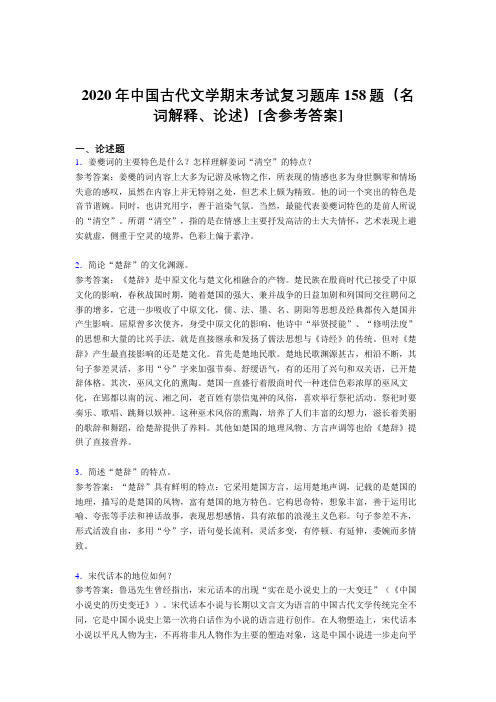
2020年中国古代文学期末考试复习题库158题(名词解释、论述)[含参考答案]一、论述题1.姜夔词的主要特色是什么?怎样理解姜词“清空”的特点?参考答案:姜夔的词内容上大多为记游及咏物之作,所表现的情感也多为身世飘零和情场失意的感叹,虽然在内容上并无特别之处,但艺术上颇为精致。
他的词一个突出的特色是音节谐婉。
同时,也讲究用字,善于渲染气氛。
当然,最能代表姜夔词特色的是前人所说的“清空”。
所谓“清空”,指的是在情感上主要抒发高洁的士大夫情怀,艺术表现上避实就虚,侧重于空灵的境界,色彩上偏于素净。
2.简论“楚辞”的文化渊源。
参考答案:《楚辞》是中原文化与楚文化相融合的产物。
楚民族在殷商时代已接受了中原文化的影响,春秋战国时期,随着楚国的强大、兼并战争的日益加剧和列国间交往聘问之事的增多,它进一步吸收了中原文化,儒、法、墨、名、阴阳等思想及经典都传入楚国并产生影响。
屈原曾多次使齐,身受中原文化的影响,他诗中“举贤授能”、“修明法度”的思想和大量的比兴手法,就是直接继承和发扬了儒法思想与《诗经》的传统。
但对《楚辞》产生最直接影响的还是楚文化。
首先是楚地民歌。
楚地民歌渊源甚古,相沿不断,其句子参差灵活,多用“兮”字来加强节奏、舒缓语气,有的还用了兴句和双关语,已开楚辞体格。
其次,巫风文化的熏陶。
楚国一直盛行着殷商时代一种迷信色彩浓厚的巫风文化,在郢都以南的沅、湘之间,老百姓有崇信鬼神的风俗,喜欢举行祭祀活动。
祭祀时要奏乐、歌唱、跳舞以娱神。
这种巫术风俗的熏陶,培养了人们丰富的幻想力,滋长着美丽的歌辞和舞蹈,给楚辞提供了养料。
其他如楚国的地理风物、方言声调等也给《楚辞》提供了直接营养。
3.简述“楚辞”的特点。
参考答案:“楚辞”具有鲜明的特点:它采用楚国方言,运用楚地声调,记载的是楚国的地理,描写的是楚国的风物,富有楚国的地方特色。
它构思奇特,想象丰富,善于运用比喻、夸张等手法和神话故事,表现思想感情,具有浓郁的浪漫主义色彩。
北京师范大学2019-2020学年第一学期期末中国文学考试试卷

装订线北京师范大学2019-2020学年第一学期期末考试试卷(A卷)课程名称:中国文学任课教师姓名:卷面总分:分考试时长:分钟考试类别:闭卷□开卷□其他□院(系):专业:年级:姓名:学号:阅卷教师(签字):一、名词解释题(从以下6题中选做4题,每题限100字以内,每题5分,共20分)1.五四文学革命2.文学研究会3.创造社4.“语丝”文体5.乡土小说6.湖畔诗社二、简答题(从以下五题中选做3题,每题限300字以内,每题15分,共45分)1.郭沫若在中国现代诗歌史上有什么开创性贡献?2.茅盾的《子夜》对中国现代长篇小说创作有什么贡献?3.郁达夫早期小说有怎样的艺术特色?4.闻一多提出的诗歌创作的“三美”原则是什么?有什么意义?5.晚清文学对五四新文学有哪些重要影响?三、论述题(以下二题中选做一题,限800字以内,35分)1.结合具体创作,试论第一个“十年”新文学创作的主要成就。
2.以具体作品为例,阐述鲁迅小说对知识分子命运的思考。
装订线北京师范大学2019 ~2020 学年第一学期期末考试试卷(B卷)课程名称:任课教师姓名:卷面总分:分考试时长:分钟考试类别:闭卷□开卷□其他□院(系):专业:年级:姓名:学号:阅卷教师(签字):一、名词解释题(从以下6题中选做4题,每题限100字以内,每题5分,共20分)1.晚清文学改良运动2.文明戏3.五四白话文运动4.新潮作家群5.语丝社6.新格律诗二、简答题(从以下五题中选做3题,每题限300字以内,每题15分,共45分)1.胡适在中国现代诗歌史上有什么开创性贡献?2.结合作品简析郁达夫小说的创作特色。
3.谈谈茅盾《子夜》对民族资本家形象的塑造。
4.简述你对朱自清散文独特艺术价值的看法。
5.简述“五四”前后“问题小说”的创作特色。
三、论述题(以下二题中选做一题,限800字以内,35分)1.以具体作品为例,阐述鲁迅小说的思想意义。
2.结合代表性的诗人诗作,论述中国现代文学第一个十年新诗的发展变化。
《中国古代文学(B)(2)》2018-2019期末试题及答案

《中国古代文学(B)(2)》2018-2019期末试题及答案一、填空(每空1分,共20分)1.“疏影横斜水清浅,暗香浮动月黄昏”是宋代隐士诗人____的咏梅绝唱《山园小梅》中的名句。
2.宋代词人____在名作《鹊桥仙》中用“两情若是久长时,又岂在朝朝暮暮”来歌颂真诚专一的爱情。
3.北宋词人____的一些词作展现了北宋的都市生活和市井风情,其中最著名的是描写杭州的《望海潮》(东南形胜)。
4.著名的咏柳词《兰陵王》(柳阴直)是北宋词人____的慢词代表作之一。
5.宋代诗人____ 以“活法”作诗,创作了轻快活脱的“诚斋体”。
6.南宋后期学习晚唐诗人贾岛、姚合,标榜野逸清瘦诗风的诗派是“____”。
7.王国维称元代杂剧作家纪君祥的杂剧《______》“即列之于世界大悲剧中,亦无愧色也”。
8.所谓“荆、刘、拜、杀”是四部南戏《____》《白兔记》《拜月亭》和《杀狗记》的合称。
9.关汉卿的杂剧《窦娥冤》写窦娥因恶汉____的诬陷而被问成死罪斩首的故事。
10.明代作家____编写的《初刻拍案惊奇》和《二刻拍案惊奇》简称为“二拍”。
11。
明代白话短篇小说《____》通过兴哥和王三巧的爱情婚姻故事反映出一种新的爱情观念和道德观念。
12.明代梁辰鱼的传奇《____》是第一部用魏良辅改革后的昆山腔演唱的戏曲作品,扩大了这种声腔的影响。
13.明代作家____的杂剧《雌木兰替父从军》描写了花木兰女扮男装替父从军的故事。
14.清代影响最大的一个散文流派是“____”,姚鼐是其代表。
15.清代孔尚任的传奇《桃花扇》以复社名士侯方域和秦淮歌妓____的爱情故事为线索,展示了南明王朝兴亡的历史。
16.严监生和严贡生是清代长篇小说《____》塑造的著名人物形象。
17.袁宏道是明代著名文学流派“____”的代表人物,他文学主张的核心是“独抒性灵,不拘格套”。
18.所谓“晚清四大谴责小说”指的是《官场现形记》《____》《二十年目睹之怪现状》和《孽海花》。
中国文学期末复习资料

中国文学期末复习资料中国文学十五讲一、填空每空1分,共10分二、名词解释每题5分,共20分三、简答每题10分,共40分四、论述题(展开说明)每题15分,共30分第一讲:古代第一部诗歌总集——《诗经》1、远古歌谣是源于劳动实践的需要而产生的。
2、原始的诗歌并不是独立存在的,而是跟音乐和舞蹈结合在一起的。
3、《诗经》的搜集:采诗制度、制礼作乐、公卿献诗4、《诗经》原来只称为“诗”,因为它收录的作品实际篇数为305篇,取其成数又称为“诗三百”。
5、《诗经》全书分为三个部分:风、雅、颂。
这是音乐上的分类。
6、《诗经》的传授:齐国人辕固生、鲁国人申培、燕国人韩婴、鲁国人毛亨赵国人毛苌“毛诗”7、《诗经》开创的中国古典诗歌的思想传统。
结合具体作品,谈谈《诗经》的主题倾向。
简述《诗经》的思想内容,并举例说明。
反抗压迫剥削的诗篇诗经中反压迫剥削的诗篇:一方面表现了奴隶们的悲惨生活,他们遭受奴隶主阶级的残酷剥削和压迫。
《七月》另一方面由于残酷的压迫和剥削,激起了被压迫奴隶们强烈的不满和反抗。
劳役:《伐檀》、《硕鼠》兵役:《君子于役》、《无衣》描写爱情婚姻的诗篇描写劳动生活的诗篇政治讽刺诗古老的史诗8、诗经的现实主义精神以素朴自然的手法,描绘真实的生活画面,具有浓厚的生活气息。
在真实描绘现实生活的基础上,鲜明地记录了歌者的是非观念和爱憎情感。
通过对诗歌主人公情感、语言、动作的描写,塑造出鲜明生动的人物形象。
运用对比的手法,突出生活的矛盾,使生活画面更加鲜明。
9、诗经的艺术特色和成就——中国古典诗歌光辉的现实主义传统的发端,(一)现实主义精神和现实主义创作特色第一,植根于对现实生活作真实描绘基础上的鲜明的是非观念和强烈的爱憎感情;第二,善于以朴素自然的手法,通过真实的生活画面的描绘来反映出社会生活的本质,并且表现出浓厚的生活气息;第三,通过抒情主人公内心思想感情、语言或行动造出鲜明生动的人物形象;第四,运用对比的手法,以突出生活的矛盾,使生活画面更加鲜明生动(二)灵活多变的句式(以四言为主,而又富于变化)和重叠复沓的章法(回环往复、重叠复沓的结构形式收到了很好的艺术效果)(三)赋(铺陈叙述,直接陈述描写)比(比喻象征手法)兴(发端联想法)的表现手法(四)朴素凝练和富于音乐美的语言第二讲——屈原和《楚辞》1、楚辞产生的相关要素社会历史原因:采诗制度废止—诗的衰落社会历史的激变—新诗体的产生文学艺术传统:楚地民歌;楚地的巫风;楚国的音乐方言;北方文化的借鉴:四言诗—《橘颂》、《天问》北方散文—铺叙、夸张、渲染2、屈原是中国文学史上出现的第一个伟大诗人,《楚辞》是中国文学史中有作者姓名的第一部文人创作的诗歌总集。
艺术高中语文文学期末试卷

一、选择题(每题2分,共20分)1. 下列词语中,字形、字音完全正确的一项是:A. 潇洒(xiāo sǎ)炽热(chì rè)纷繁(fēn fán)B. 惊愕(jīng è)雕琢(diāo zhuó)震慑(zhèn shè)C. 沉默(chén mò)雕版(diāo bǎn)沦落(lún luò)D. 畅快(chàng kuài)豁达(huò dá)舒适(shū shì)2. 下列句子中,没有语病的一项是:A. 通过这次比赛,使他在众多选手中脱颖而出。
B. 她的歌声如泉水般清澈,如山涧般悠扬。
C. 他的画作在国内外享有盛誉,被誉为“东方毕加索”。
D. 我喜欢听音乐,尤其是古典音乐,因为它能陶冶情操。
3. 下列诗句中,使用了比喻手法的一项是:A. 海内存知己,天涯若比邻。
B. 千里共婵娟,万里无云踪。
C. 春风得意马蹄疾,一日看尽长安花。
D. 两岸猿声啼不住,轻舟已过万重山。
4. 下列作品,属于浪漫主义文学的是:A. 《红楼梦》B. 《呐喊》C. 《巴黎圣母院》D. 《骆驼祥子》5. 下列作家,不属于“新月派”的是:A. 徐志摩B. 郭沫若C. 林徽因D. 沈从文6. 下列词语中,不属于艺术手法的一项是:A. 象征B. 比喻C. 对比D. 排比7. 下列文学流派,属于现实主义的是:A. 现代派B. 浪漫主义C. 自然主义D. 象征主义8. 下列作品,属于“五四”新文化运动时期的文学作品是:A. 《狂人日记》B. 《围城》C. 《红楼梦》D. 《水浒传》9. 下列句子中,使用了拟人手法的一项是:A. 雨滴轻轻地敲打着窗户,仿佛在低声吟唱。
B. 花儿在微风中摇曳,宛如少女的舞姿。
C. 月亮躲在云层后面,害羞地不肯露面。
D. 树叶在阳光下闪烁,像是跳动的音符。
文学艺术课考试题及答案
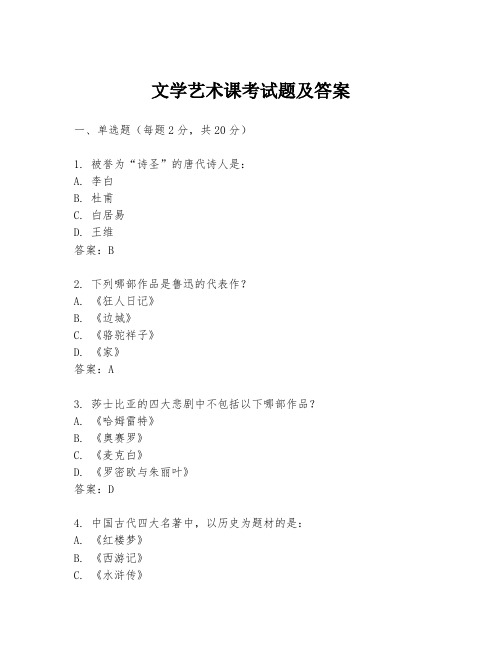
文学艺术课考试题及答案一、单选题(每题2分,共20分)1. 被誉为“诗圣”的唐代诗人是:A. 李白B. 杜甫C. 白居易D. 王维答案:B2. 下列哪部作品是鲁迅的代表作?A. 《狂人日记》B. 《边城》C. 《骆驼祥子》D. 《家》答案:A3. 莎士比亚的四大悲剧中不包括以下哪部作品?A. 《哈姆雷特》B. 《奥赛罗》C. 《麦克白》D. 《罗密欧与朱丽叶》答案:D4. 中国古代四大名著中,以历史为题材的是:A. 《红楼梦》B. 《西游记》C. 《水浒传》D. 《三国演义》答案:D5. 以下哪位画家不属于印象派?A. 莫奈B. 梵高C. 毕加索D. 德加答案:C6. 《百年孤独》的作者是:A. 加西亚·马尔克斯B. 博尔赫斯C. 聂鲁达D. 略萨答案:A7. 以下哪位作曲家不属于古典音乐时期?A. 巴赫B. 海顿C. 贝多芬D. 肖邦答案:D8. 中国古代文学中,以诗歌形式记录历史的作品是:A. 《史记》B. 《汉书》C. 《诗经》D. 《资治通鉴》答案:C9. 以下哪位作家不是法国人?A. 雨果B. 莫泊桑C. 巴尔扎克D. 狄更斯答案:D10. 现代主义文学的代表人物之一是:A. 海明威B. 托尔斯泰C. 马克·吐温D. 狄更斯答案:A二、多选题(每题3分,共15分)11. 以下哪些作品属于现实主义文学?A. 《安娜·卡列尼娜》B. 《老人与海》C. 《悲惨世界》D. 《百年孤独》答案:A、B、C12. 中国古代四大发明包括:A. 造纸术B. 印刷术C. 火药D. 指南针答案:A、B、C、D13. 以下哪些是文艺复兴时期的代表人物?A. 达芬奇B. 米开朗基罗C. 但丁D. 歌德答案:A、B、C14. 以下哪些作品属于现代主义文学?A. 《尤利西斯》B. 《追忆似水年华》C. 《等待戈多》D. 《百年孤独》答案:A、B、C、D15. 以下哪些是浪漫主义音乐的特点?A. 强调个人情感的表达B. 重视和声与对位的运用C. 倾向于使用民族音乐元素D. 追求音乐的绝对美答案:A、C三、简答题(每题10分,共30分)16. 简述“文艺复兴”运动的主要特点。
- 1、下载文档前请自行甄别文档内容的完整性,平台不提供额外的编辑、内容补充、找答案等附加服务。
- 2、"仅部分预览"的文档,不可在线预览部分如存在完整性等问题,可反馈申请退款(可完整预览的文档不适用该条件!)。
- 3、如文档侵犯您的权益,请联系客服反馈,我们会尽快为您处理(人工客服工作时间:9:00-18:30)。
西安外国语大学考试试题编号:2012-2013学年第 2 学期系(院、部):英文学院专业:英语课程:中国文学与艺术班级: 12级专选命题时间: 13年12月命题教师:苗淼以上栏目由命题教师填写,下栏由考生填写学号: 1201010609 姓名:左茜系(院):英文学院专业:英语班级: 6 班Essay questions (25% each)Directions: answer the following questions accurately and concisely by using the information covered in ‘Chinese Literature and Art’.I. Questions for Chinese Art1.What is taotie? During which dynasty or dynasties was it most popular? Whatare some hypothesis concerning the meanings or origins of taotie?(1) Taotie is a mythical ferocious animal in Chinese legend which people saidwas the fifth son of dragon. Taotie was always seen on the surface of ancient bronze wares as decoration.(2) Taotie is a motif commonly found on Chinese ritual bronze vessels from theShang and Zhou Dynasty. And in Shang dynasty and Zhou dynasty, it was very popular.(3) Because Taotie’s biggest character is that it can eat lots of things, so it is asymbol of greed. It is said that this monster had no body, only a big head and a big mouth. For it was too greedy for eating so that it ate its own body!2.What are some characteristics of Tang dynasty (early and mid-Tang) art?Name one artist for each time period, and explain how this artist represents the achievement of his time.(1) The Tang Dynasty was an exceptional period in China's history. Thesociety was prosperous and stable and had achieved great success in culture, art and writing. Writing poems was a major cultural activity and even the imperial civil examination began to require poem writing instead of essay writing. "A Complete Collection of Tang Poems" includes nearly 50,000 works from morethan 2,300 poets.(2) 1. Tang period (618-712): The most outstanding poet during this time isChen Zi'ang. His poems were vigorous and straightforward. He felt that poems should reflect reality and he helped lay the groundwork for the development of Tang Poems.2. High Tang (712-762) was the highest level of Tang poetry. The topics andstyles of the poems were rich and varied. Poets wrote freely in a romantic atmosphere, some singing the praises of nature, some yearning for life at a frontier fortress, some sighing with frustration. Some of the most famous poets in High Tang included Li Bai, Du Fu, Meng Haoran, Gao Shi and Cen Sen. Cen Sen had a gift for writing poems about frontier fortresses, while Gao Shi wrote about the miserable life of poor people. The "Fairy Poet" Li Bai and "Sage Poet" Du Fu probably had the most profound influences on writing at that time.Together, they created an imposing scene that had immense influences on later writers.3. In the Mid Tang lived the famous poets Bai Juyi, Yuan Zhen and Li He.Bai Juyi was an expert at satire. He mocked excessive taxes, objected to war and criticized high-ranking officials. He tried to make his language plain, smooth and lively so that more people could appreciate his poem.4. The Late Tang period (827-859) saw the well-known poets Li Shangyinand Du Mu. Du Mu' poems were fresh and cool and expressed his sadness and frustration in his official career. There is still debate today over his famous poem "Untitled". Critics argue over weather the poem is a love song or a political statement.II. Questions for Chinese Literature3.What kind of book is the Classic of Songs (Shi Jing)? How is it further divided,and why is it important to the Chinese literary tradition?(1) The Classic of Songs is the most ancient existing anthology of Chinesepoetry. The Classic of Songs comprises 305 poems and songs dating from the 11th to 7th centuries BC. The Classic of Songs is one of the "Five Classics"traditionally said to have been compiled by Confucius, and has been studied and memorized by scholars in China and neighboring countries over two millennia, and subsequently more globally, with many translations into numerous languages.Since the Qing dynasty, its rhyme patterns have also been analyzed in the study of Old Chinese phonology.(2) The content of the Poetry can be divided into two main sections: the "Airs of the States", and the eulogies and hymns. The "Airs of the States" are shorter lyrics in simple language that are generally ancient folk songs which record the voice of the common people. They often speak of love and courtship, longing for an absent lover, soldiers on campaign, farming and housework, and political satire and protest. On the other hand, songs in the two "Hymns" sections and the "Eulogies" section tend to be longer ritual or sacrificial songs, usually in the forms of courtly panegyrics and dynastic hymns which praise the founders of the Zhou dynasty. They also include hymns used in sacrificial rites and songs used by the aristocracy in their sacrificial ceremonies or at banquets. Pieces of poems not collected was recorded in Zuo Zhuan.(3) Classic of Songs is the start of Chinese literacy, and it has the highly position in Chinese literacy. It is important because Classic of Songs established the Chinese poetry’s creation, and it settled the Chinese culture tradition. The tradition is something about the emotion, crowd arts and realism. In addition to this, Classic of Songs still ensure the principle of Chinese poetry and justice. Classic of Songs also ensure the basic of poetry’s language form.4.What genre would Liaozhai Zhiyi belong to according to moderncategorization? How do you understand the ways Pu Songling portrays the supernatural experiences that have been recorded as “strange tales”? And what factors distinguish the stories from other Chinese literary classics?(1) Liaozhai Zhiyi belongs to fantasy fiction.Pu borrows from a tradition oforal storytelling where the boundary between reality and the odd or fantastic is blurred. The stories are filled with magical foxes, ghosts , scholars, jiangshi, court officials, Taoist exorcists and beasts.(2)Pu songling was very poor during his whole span life, and of course it isthe advantage of him to create such a kind of book. And also, he has thedeeply feeling about ancient Chinese Imperial system, so it is the reason that he put his strong feeling in this very book, and criticize this regular’sdisadvantages. The author just use this way by writing about the supernatural to reflect the reaction. In this book, the author uses many supernatural(something like ghost and spirit) to reflect the dream in author’s heart. This book also portrays some obstacle that many people were met in the ancientchina, and in the end, the author just makes them all succeed; it reflects the author’s fighting conscience. Another aspect is that through those supernatural, the author reflect the darkness of the society and the corruption of the polity. This book has the high value of the moral and thought.(3) Liaozhai Zhiyi was the first novel that was writing through the supernatural to express the reaction, so the factor actors distinguish the stories from other Chinese literary classics I think was that it writes by the supernatural.。
